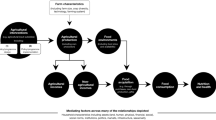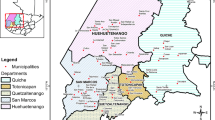Abstract
Despite considerable development investment, food insecurity remains prevalent throughout East and West Africa. The concept of ‘sustainable intensification’ of agricultural production has been promoted as a means to meet growing food needs in these regions. However, inadequate attention has been given to assessing whether benefits from intensification would be realized by farm households considering highly diverse resource endowments, household and farm characteristics, and agroecological contexts. In this study, we apply a simple energy-based index of food availability to 1800 households from research sites in 7 countries in East and West Africa to assess the food availability status of each of these households and to quantify the contribution of different on- and off-farm activities to food availability. We estimate the effects of two production intensification strategies on food availability: increased cereal crop production from crop-based options, and increased production of key livestock products from livestock-based options. These two options are contrasted with a third strategy: increased off-farm income for each household from broader socioeconomic-based options. Using sensitivity analysis, each strategy is tested against baseline values via incremental production increases. Baseline results exhibit considerable diversity within and across sites in household food availability status and livelihood strategies. Interventions represented in the crop and livestock options may primarily benefit food-adequate and marginally food-inadequate households, and have little impact on the most food-inadequate households. The analysis questions what production intensification can realistically achieve for East and West African smallholders, and how intensification strategies must be augmented with transformational strategies to reach the poorest households.






Similar content being viewed by others
References
Alexandratos, N., & Bruinsma, J. (2012). World agriculture towards 2030/2050: the 2012 revision. ESA Working paper No. 12–03. Rome: FAO.
Berg, A., de Noblet-Ducoudré, N., Sultan, B., Lengaigne, M., & Guimberteau, M. (2013). Projections of climate change impacts on potential C4 crop productivity over tropical regions. Agricultural and Forest Meteorology, 170, 89–102. doi:10.1016/j.agrformet.2011.12.003.
Carletto, C., Zezza, A., & Banerjee, R. (2013). Towards better measurement of household food security: harmonizing indicators and the role of household surveys. Global Food Security, 2(1), 30–40. doi:10.1016/j.gfs.2012.11.006.
Carletto, C., Jolliffe, D., & Banerjee, R. (2015). From tragedy to renaissance: improving agricultural data for better policies. The Journal of Development Studies, 51(2), 133–148. doi:10.1080/00220388.2014.968140.
CIESIN, CIAT. Gridded Population of the World, Version 3 (GPWv3): Population Density Grid, Future Estimates (2005). NASA Socioeconomic Data and Applications Center (SEDAC). doi:10.7927/H4ST7MRB. Accessed 27 March 2015.
Coates, J. (2013). Build it back better: deconstructing food security for improved measurement and action. Global Food Security, 2(3), 188–194. doi:10.1016/j.gfs.2013.05.002.
Coates, J., Frongillo, E. A., Rogers, B. L., Webb, P., Wilde, P. E., & Houser, R. (2006). Commonalities in the experience of household food insecurity across cultures: what are measures missing? The Journal of Nutrition, 136(5), 1438S–1448S.
Collier, P., & Dercon, S. (2014). African agriculture in 50 Years: smallholders in a rapidly changing world? World Development, 63, 92–101. doi:10.1016/j.worlddev.2013.10.001.
Dixon, J., Gulliver, A., & Gibbon, D. (2001). Farming systems and poverty: improving farmers’ livelihoods in a changing world. Rome and Washington, DC: FAO and World Bank.
Douxchamps, S., Van Wijk, M. T., Silvestri, S., Moussa, A. S., Quiros, C., Ndour, N. Y. B., et al. (2016). Linking agricultural adaptation strategies, food security and vulnerability: evidence from West Africa. Regional Environmental Change, 16(5), 1305–1317. doi:10.1007/s10113-015-0838-6.
FAO (1999). The strategic framework for FAO 2000–2015. Rome: Food and Agriculture Organization of the United Nations.
FAO (2001). Human energy requirements: report of a joint FAO/WHO/UNU expert consultation. FAO Food and Nutrition Technical Report Series No. 1. Rome: Food and Agriculture Organization of the United Nations.
FAO (2012). FAO statistical yearbook 2012. Rome: FAO.
Förch, W., Sijmons, K., Mutie, I., Kiplimo, J., Cramer, L., Kristjanson, P., et al. (2013). Core Sites in the CCAFS Regions: East Africa, West Africa and South Asia, Version 3. In CGIAR Research Program on Climate Change, Agriculture and Food Security (CCAFS). Copenhagen. https://cgspace.cgiar.org/handle/10568/10203.
Frelat, R., Lopez-Ridaura, S., Giller, K. E., Herrero, M., Douxchamps, S., Djurfeldt, A., et al. (2015). Drivers of household food availability in sub-Saharan Africa based on big data from small farms. Proceedings of the National Academy of Sciences of the United States of America, 113(2), 458–463. doi:10.1073/pnas.1518384112.
Graziano da Silva, J. (2012). Keynote Address. In Conference Proceedings Economist (ed). Geneva: Feeding the World in 2050. http://www.fao.org/fileadmin/user_upload/FAODG/docs/2012-02-08-DG_Economist_Conference-FINAL.pdf.
Hammond, J., Fraval, S., van Etten, J., Suchini, J. G., Mercado, L., Pagella, T., et al. (2016). The rural household multi-indicator survey (RHoMIS) for rapid characterisation of households to inform climate smart agriculture interventions: description and applications in East Africa and central America. Agricultural Systems. doi:10.1016/j.agsy.2016.05.003.
Harris, D., & Orr, A. (2014). Is rainfed agriculture really a pathway from poverty? Agricultural Systems, 123, 84–96. doi:10.1016/j.agsy.2013.09.005.
Hazell, P. B. R. (2005). Is there a future for small farms? Agricultural Economics, 32, 93–101. doi:10.1111/j.0169-5150.2004.00016.x.
Herrero, M., Thornton, P. K., Notenbaert, A. M., Wood, S., Msangi, S., Freeman, H. A., et al. (2010). Smart investments in sustainable food production: revisiting mixed crop–livestock systems. Science, 327, 822–825.
Herrero, M., Thornton, P. K., Bernués, A., Baltenweck, I., Vervoort, J., van de Steeg, J., et al. (2014). Exploring future changes in smallholder farming systems by linking socio-economic scenarios with regional and household models. Global Environmental Change, 24(1), 165–182. doi:10.1016/j.gloenvcha.2013.12.008.
Howden, S. M., Soussana, J. F., Tubiello, F. N., Chhetri, N., Dunlop, M., & Meinke, H. (2007). Adapting agriculture to climate change. Proceedings of the National Academy of Sciences of the United States of America, 104(50), 19691–19696. doi:10.1073/pnas.0701890104.
Humidtropics (2012). Humidtropics: integrated systems for the humid tropics program. International Institute for Tropical Agriculture (IITA). Ibadan. http://humidtropics.org/wpcontent/uploads/downloads/2012/10/crp_1.2_humid_tropics_proposal_15August_2012.pdf.
IWYP (2012). International Wheat Yield Partnership. iwyp.org. Accessed 23 August 2016.
Jayne, T. S., Chamberlin, J., & Headey, D. D. (2014). Land pressures, the evolution of farming systems, and development strategies in Africa: a synthesis. Food Policy, 48, 1–17. doi:10.1016/j.foodpol.2014.05.014.
Knox, J., Hess, T., Daccache, A., & Wheeler, T. (2012). Climate change impacts on crop productivity in Africa and South Asia. Environmental Research Letters, 7(3). doi:10.1088/1748-9326/7/3/034032.
Kristjanson, P., Mango, N., Krishna, A., Radeny, M., & Johnson, N. (2010). Understanding povery dynamics in Kenya. Journal of International Development, 22(7), 978–996. doi:10.1002/jid.1598.
Licker, R., Johnston, M., Foley, J. A., Barford, C., Kucharik, C. J., Monfreda, C., et al. (2010). Mind the gap: how do climate and agricultural management explain the ‘yield gap’ of croplands around the world? Global Ecology and Biogeography, 19(6), 769–782. doi:10.1111/j.1466-8238.2010.00563.x.
Mabiso, A., Cunguara, B., & Benfica, R. (2014). Food (in)security and its drivers: insights from trends and opportunities in rural Mozambique. Food Security, 6(5), 649–670. doi:10.1007/s12571-014-0381-1.
Otsuka, K., & Yamano, T. (2006). Introduction to the special issue on the role of nonfarm income in poverty reduction: evidence from Asia and East Africa. Agricultural Economics, 35(3), 393–397. doi:10.1111/j.1574-0862.2006.00185.x.
Pretty, J. N., Toulmin, C., & Williams, S. (2011). Sustainable intensification in African agriculture. International Journal of Agricultural Sustainability, 9(1), 5–24. doi:10.3763/ijas.2010.0583.
Ritzema, R. S., Frelat, R., Hammond, J., & van Wijk, M. T. (2016). What works where for which farm household: rapid approaches to food availability analysis. In I. Ӧborn, B. Vanlauwe, M. Phillips, R. Thomas, & K. Atta-Krah (Eds.), Integrated Systems Research for Sustainable Intensification of Smallholder Agriculture. London: Earthscan.
Silvestri, S., Rufino, M. C., Quiros, C., Douxchamps, S., Teufel, N., Singh, D., et al. (2014). Impact Lite Dataset. Harvard Dataverse, V2. CGIAR Research Program on Climate Change, Agriculture and Food Security (CCAFS). Cambridge. doi:10.7910/DVN/24751.
Silvestri, S., Douxchamps, S., Kristjanson, P., Förch, W., Radeny, M., Mutie, I., et al. (2015). Households and food security: lessons from food secure households in East Africa. Agriculture & Food Security, 4(1), 1–15. doi:10.1186/s40066-015-0042-4.
Thornton, P. K., & Herrero, M. (2001). Integrated crop-livestock simulation models for scenario analysis and impact assessment. Agricultural Systems, 70(2–3), 581–602. doi:10.1016/s0308-521x(01)00060-9.
Tittonell, P. (2014). Ecological intensification of agriculture - sustainable by nature. Current Opinion in Environmental Sustainability, 8, 53–61.
Tittonell, P., & Giller, K. E. (2013). When yield gaps are poverty traps: the paradigm of ecological intensification in African smallholder agriculture. Field Crops Research, 143, 76–90. doi:10.1016/j.fcr.2012.10.007.
Tittonell, P., Muriuki, A., Shepherd, K. D., Mugendi, D., Kaizzi, K. C., Okeyo, J., et al. (2010). The diversity of rural livelihoods and their influence on soil fertility in agricultural systems of East Africa - a typology of smallholder farms. Agricultural Systems, 103(2), 83–97. doi:10.1016/j.agsy.2009.10.001.
Townsend, R. F., Ceccacci, I., Cooke, S., Constantine, M., & Moses, G. (2013). Implementing agriculture for development: World Bank Group agriculture action plan (2013–2015). Washington DC: World Bank.
UNDP (2014). Human development report 2014. Sustaining human progress: reducing vulnerabilities and building resilience. New York: United Nations Development Programme.
USDA (2015). National Nutrient Database for Standard Reference Release 27. http://ndb.nal.usda.gov/ndb/search/list. Accessed 22 July 2015.
van Wijk, M. T., Tittonell, P., Rufino, M. C., Herrero, M., Pacini, C., Ridder, N., et al. (2009). Identifying key entry-points for strategic management of small-holder farming systems in sub-Saharan Africa using the dynamic farm-scale simulation model NUANCES-FARMSIM. Agricultural Systems, 102, 89–101.
van Wijk, M. T., Rufino, M. C., Enahoro, D., Parsons, D., Silvestri, S., Valdivia, R. O., et al. (2014). Farm household models to analyse food security in a changing climate: a review. Global Food Security, 3(2), 77–84. doi:10.1016/j.gfs.2014.05.001.
Vanlauwe, B., Coyne, D., Gockowski, J., Hauser, S., Huising, J., Masso, C., et al. (2014). Sustainable intensification and the African smallholder farmer. Current Opinion in Environmental Sustainability, 8, 15–22. doi:10.1016/j.cosust.2014.06.001.
Waithaka, M. M., Thornton, P. K., Herrero, M., & Shepherd, K. D. (2006). Bio-economic evaluation of farmers’ perceptions of viable farms in western Kenya. Agricultural Systems, 90, 243–271.
WFP (2012). Food security assessments in zones at risk. Rome: World Food Programme.
WFP (2013). Comprehensive food security and vulnerability analysis: Ghana 2012. Rome: WFP/VAM.
Zingore, S., Murwira, H. K., Delve, R. J., & Giller, K. E. (2007). Influence of nutrient management strategies on variability of soil fertility, crop yields and nutrient balances on smallholder farms in Zimbabwe. Agriculture Ecosystems & Environment, 119(1–2), 112–126. doi:10.1016/j.agee.2006.06.019.
Acknowledgements
This research was conducted with the support of the CGIAR Research Programs on Integrated Systems in the Humid Tropics (Humidtropics) and Climate Change, Agriculture and Food Security (CCAFS). Data used for this study were collected from CCAFS study sites in East and West Africa.
Author information
Authors and Affiliations
Corresponding author
Rights and permissions
About this article
Cite this article
Ritzema, R.S., Frelat, R., Douxchamps, S. et al. Is production intensification likely to make farm households food-adequate? A simple food availability analysis across smallholder farming systems from East and West Africa. Food Sec. 9, 115–131 (2017). https://doi.org/10.1007/s12571-016-0638-y
Received:
Accepted:
Published:
Issue Date:
DOI: https://doi.org/10.1007/s12571-016-0638-y




